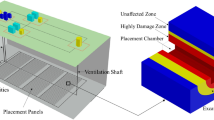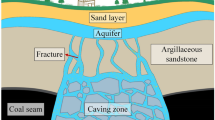Abstract
In this study, a hydromechanical model for fluid flow in fractured porous media is presented. We assume viscous fluids and the coupling equations are derived from the mass and momentum balance equations for saturated porous media. The fluid flow through discrete cracks will be modelled by the extended finite element method and an implicit time integration scheme. We also present a consistent linearization of the underlying non-linear discrete equations. They are solved by the Newton-Raphson iteration procedure in combination with a line search. Furthermore, the model is extended to includes crack propagation. Finally, examples are presented to demonstrate the versatility and efficiency of this two-scale hydromechanical model. The results suggest that the presence of the fracture in a deforming, porous media has great impact on the fluid flow and deformation patterns.
Similar content being viewed by others
References
Bažant Z P. Size effect in blunt fracture: concrete, rock, metal. Journal of Engineering Mechanics, 1984, 110(4): 518–535
Moës N, Dolbow J, Belytschko T. A finite element method for crack growth without remeshing. International Journal for Numerical Methods in Engineering, 1999, 46: 131–150
Belytschko T, Black T. Elastic crack growth in finite elements with minimal remeshing. International Journal for Numerical Methods in Engineering, 1999, 45(5): 601–620
Wang H, Belytschko T. Fluid–structure interaction by the discontinuous-galerkin method for large deforma-tions. International Journal for Numerical Methods in Engineering, 2009, 77(1): 30–49
Gerstenberger A, Wall W A. An extended finite element method/lagrange multiplier based approach for fluid–structure interaction. Computer Methods in Applied Mechanics and Engineering, 2008, 197(19‒20): 1699–1714
Rabczuk T, Gracie R, Song J H, Belytschko T. Immersed particle method for fluid-structure interaction. International Journal for Numerical Methods in Engineering, 2010, 22: 48
Réthoré J, Borst R, Abellan M A. A two-scale approach for fluid flow in fractured porous media. International Journal for Numerical Methods in Engineering, 2007, 71(7): 780–800
Song J H, Areias P, Belytschko T. A method for dynamic crack and shear band propagation with phantom nodes. International Journal for Numerical Methods in Engineering, 2006, 67(6): 868–893
Hansbo A, Hansbo P. A finite element method for the simulation of strong and weak discontinuities in solid mechanics. Computer Methods in Applied Mechanics and Engineering, 2004, 193(33‒35): 3523–3540
Rabczuk T, Areias P, Belytschko T. A meshfree thin shell method for non-linear dynamic fracture. International Journal for Numerical Methods in Engineering, 2007, 72(5): 524–548
Vu-Bac N, Nguyen-Xuan H, Chen L, Lee C K, Zi G, Zhuang X, Liu G R, Rabczuk T. A phantom-node method with edge-based strain smoothing for linear elastic fracture mechanics. Journal of Applied Mathematics, 2013, 2013: 978026
Chau-Dinh T, Zi G, Lee P S, Rabczuk T, Song J H. Phantom-node method for shell models with arbitrary cracks. Computers & Structures, 2012, 92–93: 242–256
Rabczuk T, Zi G, Gerstenberger A, Wall W A. A new crack tip element for the phantom-node method with arbitrary cohesive cracks. International Journal for Numerical Methods in Engineering, 2008, 75(5): 577–599
Sukumar N, Chopp D L, Moës N, Belytschko T. Modeling holes and inclusions by level sets in the extended finite-element method. Computer Methods in Applied Mechanics and Engineering, 2001, 190(46‒47): 6183–6200
Areias P, Rabczuk T, Camanho P. Finite strain fracture of 2D problems with injected anisotropic softening elements. Theoretical and Applied Fracture Mechanics, 2014, 72: 50–63
Areias P, Dias-da Costa D, Sargado J, Rabczuk T. Element-wise algorithm for modeling ductile fracture with the rousselier yield function. Computational Mechanics, 2013, 52(6): 1429–1443
Areias P, Rabczuk T, Dias-da Costa D. Element-wise fracture algorithm based on rotation of edges. Engineering Fracture Mechanics, 2013, 110: 113–137
Areias P, Rabczuk T, Camanho P. Initially rigid cohesive laws and fracture based on edge rotations. Computational Mechanics, 2013, 52(4): 931–947
Areias P, Rabczuk T. Finite strain fracture of plates and shells with configurational forces and edge rotations. International Journal for Numerical Methods in Engineering, 2013, 94(12): 1099–1122
Ortiz M, Pandolfi A. Finite-deformation irreversible cohesive elements for three-dimensional crack-propagation analysis. International Journal for Numerical Methods in Engineering, 1999, 44(9): 1267–1282
Remmers J, de Borst R, Needleman A. A cohesive segments method for the simulation of crack growth. Computational Mechanics, 2003, 31(1‒2): 69–77
Belytschko T, Krongauz Y, Organ D, Fleming M, Krysl P. Meshless methods: an overview and recent developments. Computer Methods in Applied Mechanics and Engineering, 1996, 139(1–4): 3–47
Nguyen V P, Rabczuk T, Bordas S, Duflot M. Meshless methods: a review and computer implementation aspects. Mathematics and Computers in Simulation, 2008, 79(3): 763–813
Dolbow J, Belytschko T. Numerical integration of the galerkin weak form in meshfree methods. Computational Mechanics, 1999, 23(3): 219–230
Belytschko T, Guo Y, Liu W K, Xiao S P. A unified stability analysis of meshless particle methods. International Journal for Numerical Methods in Engineering, 2000, 48(9): 1359–1400
Belytschko T, Tabbara M. Dynamic fracture using element-free galerkin methods. International Journal for Numerical Methods in Engineering, 1996, 39(6): 923–938
Organ D, Fleming M, Terry T, Belytschko T. Continuous meshless approximations for nonconvex bodies by diffraction and transparency. Computational Mechanics, 1996, 18(3): 225–235
Amiri F, Anitescu C, Arroyo M, Bordas S, Rabczuk T. XLME interpolants, a seamless bridge between XFEM and enriched meshless methods. Computational Mechanics, 2014, 53(1): 45–57
Rabczuk T, Areias P. A meshfree thin shell for arbitrary evolving cracks based on an extrinsic basis. Computer Modeling in Engineering & Sciences, 2006, 16: 115–130
Zi G, Rabczuk T, Wall W. Extended meshfree methods without branch enrichment for cohesive cracks. Computational Mechanics, 2007, 40(2): 367–382
Rabczuk T, Zi G. A meshfree method based on the local partition of unity for cohesive cracks. Computational Mechanics, 2007, 39(6): 743–760
Liew K M, Zhao X, Ferreira A J M. A review of meshless methods for laminated and functionally graded plates and shells. Composite Structures, 2011, 93(8): 2031–2041
Rabczuk T, Zi G, Bordas S, Nguyen-Xuan H. A geometrically nonlinear three dimensional cohesive crack method for reinforced concrete structures. Engineering Fracture Mechanics, 2008, 75(16): 4740–4758
Bordas S, Rabczuk T, Zi G. Three-dimensional crack initiation, propagation, branching and junction in non-linear materials by an extended meshfree method without asymptotic enrichment. Engineering Fracture Mechanics, 2008, 75: 943–960
Rabczuk T, Bordas S, Zi G. A three-dimensional meshfree method for continuous multiple-crack initiation, propagation and junction in statics and dynamics. Computational Mechanics, 2007, 40(3): 473–495
Miehe C, Welschinger F, Hofacker M. Thermodynamically consistent phase-field models of fracture: variational principles and multi-field FEimplementations. International Journal for Numerical Methods in Engineering, 2010, 83(10): 1273–1311
Areias P, Msekh M, Rabczuk T. Damage and fracture algorithm using the screened poisson equation and local remeshing. Engineering Fracture Mechanics, 2016, 158: 116–143
Rabczuk T, Belytschko T. Cracking particles: a simplified meshfree method for arbitrary evolving cracks. International Journal for Numerical Methods in Engineering, 2004, 61(13): 2316–2343
Rabczuk T, Belytschko T. A three dimensional large deformation meshfree method for arbitrary evolving cracks. Computer Methods in Applied Mechanics and Engineering, 2007, 196(29‒30): 2777–2799
Rabczuk T, Zi G, Bordas S, Nguyen-Xuan H. A simple and robust three-dimensional cracking-particle method without enrichment. Computer Methods in Applied Mechanics and Engineering, 2010, 199(37–40): 2437–2455
Silling S A, Epton M, Weckner O, Xu J, Askari E. Peridynamic states and constitutive modeling. Journal of Elasticity, 2007, 88(2): 151–184
Munjiza A, Andrews K, White J. Combined single and smeared crack model in combined finite-discrete element analysis. International Journal for Numerical Methods in Engineering, 1999, 44(1): 41–57
Scholtès L, Donzé F V. Modelling progressive failure in fractured rock masses using a 3D discrete element method. International Journal of Rock Mechanics and Mining Sciences, 2012, 52: 18–30
Tan Y, Yang D, Sheng Y. Discrete element method (DEM) modeling of fracture and damage in the machining process of polycrystalline sic. Journal of the European Ceramic Society, 2009, 29(6): 1029–1037
Kulatilake P, Malama B, Wang J. Physical and particle flow modeling of jointed rock block behavior under uniaxial loading. International Journal of Rock Mechanics and Mining Sciences, 2001, 38(5): 641–657
Zeng Q y, Zhou J. Analysis of passive earth pressure due to various wall movement by particle flow code (2D). Rock and Soil Mechanics, 2005, 26: 43–47
Wang C, Tannant D. Rock fracture around a highly stressed tunnel and the impact of a thin tunnel liner for ground control. International Journal of Rock Mechanics and Mining Sciences, 2004, 41: 676–683
Jing L, Ma Y, Fang Z. Modeling of fluid flow and solid deformation for fractured rocks with discontinuous deformation analysis (DDA) method. International Journal of Rock Mechanics and Mining Sciences, 2001, 38(3): 343–355
Shi G H. Discontinuous deformation analysis: a new numerical model for the statics and dynamics of de-formable block structures. Engineering Computations, 1992, 9(2): 157–168
Pearce C, Thavalingam A, Liao Z, Bicanic N. Computational aspects of the discontinuous deformation analysis framework for modelling concrete fracture. Engineering Fracture Mechanics, 2000, 65(2–3): 283–298
Ning Y, Yang J, An X, Ma G. Modelling rock fracturing and blastinduced rock mass failure via advanced discretisation within the discontinuous deformation analysis framework. Computers and Geotechnics, 2011, 38(1): 40–49
Abellan M A, De Borst R. Wave propagation and localisation in a softening two-phase medium. Computer Methods in Applied Mechanics and Engineering, 2006, 195(37–40): 5011–5019
Lewis R W, Schrefler B A. The finite element method in the deformation and consolidation of porous media. New York: John Wiley and Sons Inc., 1987
Hassanizadeh S M, Gray W G. Mechanics and thermodynamics of multiphase flow in porous media including interphase boundaries. Advances in Water Resources, 1990, 13(4): 169–186
Darcy H. The public fountains of the city of Dijon: exhibition and application. Victor Dalmont, 1856 (in French)
Bachelor G. An Introduction to Fluid Mechanics. Cambridge University Press, 1967
Author information
Authors and Affiliations
Corresponding author
Rights and permissions
About this article
Cite this article
He, B. Hydromechanical model for hydraulic fractures using XFEM. Front. Struct. Civ. Eng. 13, 240–249 (2019). https://doi.org/10.1007/s11709-018-0490-6
Received:
Accepted:
Published:
Issue Date:
DOI: https://doi.org/10.1007/s11709-018-0490-6




